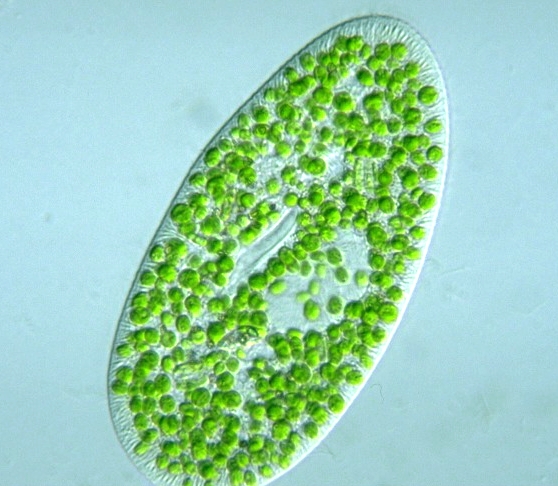 Paramecium bursaria is a species of ciliate protozoan that has a mutualistic symbiotic relationship with green alga called Zoochlorella.
Paramecium bursaria is a species of ciliate protozoan that has a mutualistic symbiotic relationship with green alga called Zoochlorella.Taxonomy:
Domain: Eukarya
Kingdom: Protista
Phylum: Ciliophora
Class: Oligohymenophorea
Order: Peniculida
Family: Parameciidae
Genus: Paramecium
Species: bursaria
Kingdom: Protista
Phylum: Ciliophora
Class: Oligohymenophorea
Order: Peniculida
Family: Parameciidae
Genus: Paramecium
Species: bursaria
Habitat:
Paramecia are widespread in freshwater environments, and are especially common in scums.
Predators:
In the 1930's a Russian biologist named Gause used Paramecium and Didinium to examine the predator-prey relationship. Both are microscopic organisms. Paramecium is the prey and Didinium is the predator.
Prey:
Paramecium feed on micro-organisms like bacteria, algae, and yeasts. To gather its food, the paramecium uses its cilia to sweep the food along with some water into the cell mouth after it falls into the oral groove. The food goes through the cell mouth into the gullet, which is like the stomach. When there is enough food in it so that it has reached a certain size it breaks away and forms a food vacuole. The food vacuole travels through the cell, through the back end first. As it moves along enzymes from the cytoplasm enter the vacuole and digest it. The digested food then goes into the cytoplasm and the vacuole gets smaller and smaller. When the vacuole reaches the anal pore the remaining undigested waste is removed.
P. bursaria is 80-150 μm long, with a wide oral groove, two contractile vacuoles, and a single micronucleus as well as a single macronucleus.
Historical information:
The first eukaryotic kingdom was the kingdom Protista. 1 billion year ago, the diverse protists appeared.
Interesting information:
The algae live inside the Paramecium in its cytoplasm and provide it with food, while the Paramecium provides the alga with movement and protection.
P. bursaria is the only species of Paramecium that forms symbiotic relationships with algae, and are often used in biology classrooms as examples of protozoans, and as examples of symbiosis.
More information on Paramecium bursaria:


No comments:
Post a Comment